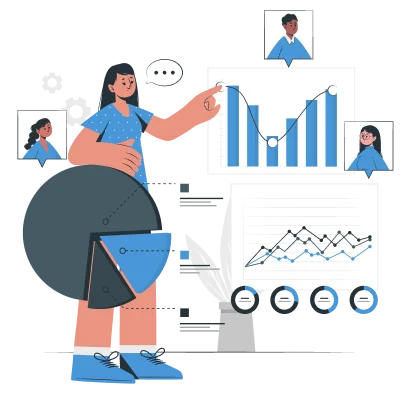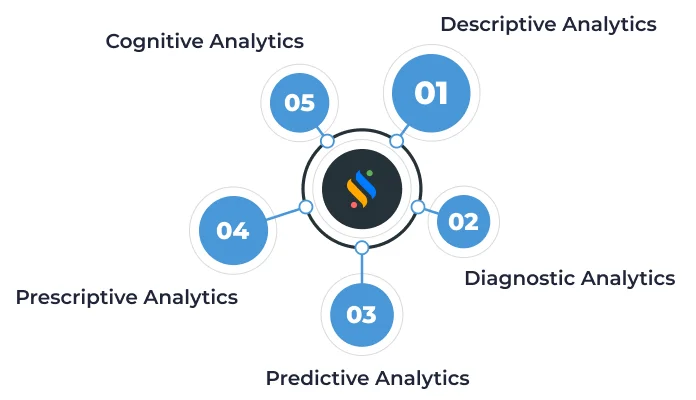Workforce analysis is the process of examining people's data to understand employee dynamics. It helps to identify trends and make informed decisions about talent management.
Grab a chance to avail 6 Months of Performance Module for FREE
Book a free demo session & learn more about it!
-
Will customized solution for your needs
-
Empowering users with user-friendly features
-
Driving success across diverse industries, everywhere.
Grab a chance to avail 6 Months of Performance Module for FREE
Book a free demo session & learn more about it!
Superworks
Modern HR Workplace
Your Partner in the entire Employee Life Cycle
From recruitment to retirement manage every stage of employee lifecycle with ease.


Seamless onboarding & offboarding
Automated compliance & payroll
Track performance & engagement
Why Workforce Analytics Is Key to Strategic Workforce Planning?
- workplace analytics software
- 8 min read
- August 20, 2024

We just want to ask the questions to HR managers,
- Are you using data effectively to manage your workforce?
- Can you predict future workforce trends?
- How do you align workforce strategies with goals?
- Are you leveraging analytics for talent management?
- What insights do you gain from workforce data?
If you are using the analytics for your office, then it will be beneficial for your future workforce planning. Let’s understand how!
Workforce analytics software is an important tool that empowers organizations to optimize their human resources. By adding data and analytics, workforce analytics enables companies to gain insights into workforce dynamics, predict future trends, and make informed decisions that drive growth and success.
In this guide, we will explore the different aspects of metrics and analytics. This can have its types, benefits, and implementation strategies. We will also delve into the latest trends and tools that are shaping the future of workforce analytics.
What Is Workforce Analytics?
Workforce analytics refers to the application of analytical processes to an organization’s human resource department.
Workforce analytics metrics involve collecting, analyzing, and interpreting workforce data to make informed decisions. It helps to make decisions regarding recruitment, retention, and overall workforce management. By leveraging workforce analytics, companies can identify trends, predict future workforce needs, and enhance employee performance.
In simple terms, workforce analytics involves the use of data and analytics to understand employees. It is also used to improve workforce performance. It goes beyond basic HR metrics to provide a deeper understanding of workforce dynamics. It enables organizations to make strategic decisions that drive business success.
Boost productivity by 20% through data-driven workforce analytics.
Start making smarter decisions with Superworks’ real-time data and analytics.
Major Types Of HR Workforce Analytics
The analytics can be categorized into several types, each serving a unique purpose in strategic workforce planning. Here are the major types:
Descriptive Analytics:
This type focuses on understanding past workforce performance by analyzing historical data. It helps HR professionals identify trends, patterns, and anomalies in workforce metrics. Additionally, by scraping data into Google Sheets, organizations can efficiently organize and analyze this historical data for more accessible and actionable insights.
Diagnostic Analytics:
Diagnostic analytics delves deeper into workforce data to identify the root causes of performance issues. It answers the “why” behind workforce trends and helps organizations understand the factors driving employee behavior.
Predictive Analytics:
One of the advanced types of workforce analytics is predictive workforce analytics. It allows organizations to forecast future workforce trends and identify potential challenges before they arise. Predictive workforce analytics helps organizations anticipate challenges and develop strategies to address them proactively. With the use of workforce analytics for competitive advantage, predictive analytics helps businesses.
Prescriptive Analytics:
This type of analytics provides actionable insights and recommendations based on the analysis of workforce data. It helps organizations determine the best course of action to optimize workforce performance.
Cognitive Analytics:
Cognitive analytics provides advanced insights into workforce dynamics. Leveraging artificial intelligence and machine learning, It can analyze unstructured data, such as employee feedback, to offer a comprehensive view of workforce sentiment.
The Benefits Of Workforce Analytics For Your Office
The implementation of the software offers numerous benefits of workforce analytics to organizations. This is enhancing their ability to manage their workforce effectively.
1. Data-Driven Decision-Making
The analytics provides HR professionals with actionable insights, enabling data-driven decision-making. By relying on data rather than intuition, organizations can make more informed choices about recruitment, talent management, and employee development.
2. Improved Workforce Planning
With analytics, companies can align their workforce strategies with business goals. By analyzing workforce data, organizations can identify skills gaps, consider employee referrals, and predict future talent needs. It helps to develop targeted recruitment and training programs.
3. Enhanced Employee Performance
The analytics enables organizations to identify high-performing employees and understand the factors contributing to their success. By analyzing performance data, companies can develop strategies to replicate success across the workforce.
4. Optimized Recruitment and Retention
By analyzing workforce data, organizations can identify the most effective recruitment channels. The analytics also helps HR professionals understand the factors contributing to employee turnover.
5. Cost Savings
The analytics allows organizations to optimize their workforce management strategies. It is leading to cost savings. By identifying inefficiencies and areas for improvement, companies can reduce costs associated with recruitment.
Why Are Workforce Metrics And Analytics Important?
Analytics plays a crucial role in helping organizations achieve their strategic objectives. Check the reasons to use Workforce planning and analytics:
1. Aligning Workforce Strategies
The analytics enables organizations to align their workforce strategies with their business objectives. By analyzing workforce data you can make the strategies.
2. Gaining a Competitive Advantage
Organizations need to leverage every available advantage. The analytics provides insights into workforce dynamics, helping companies gain a competitive edge by making informed decisions.
3. Enhancing Talent Management
Analytics empowers organizations to optimize their talent management strategies. By analyzing workforce data, companies can identify high-potential employees. It helps to develop targeted training programs. It creates succession plans to ensure a strong talent pipeline.
4. Driving Employee Engagement
By understanding workforce dynamics or workforce analytics, organizations can develop strategies to enhance employee engagement. The analytics provide insights into employee sentiment, enabling HR professionals to create a positive work environment that fosters engagement.
5. Mitigating Workforce Risks:
The analytics helps organizations identify potential risks related to workforce dynamics. By analyzing data, companies can proactively address issues such as skills gaps, turnover, and performance challenges. It minimizes the impact on business operations.
Workforce Planning And Analytics Trends and Tools
The field of analytics is constantly evolving, with new HR trends and tools. It is emerging to enhance its effectiveness. Here are some of the latest trends in workforce planning:
- Integration With HR Systems: The analytics tools are increasingly integrated with HRMS software such as Superworks. It allows organizations to streamline data collection and analysis. The integration enables HR professionals to access real-time insights. It makes informed decisions quickly.
- Use Of AI And ML: Artificial intelligence and machine learning are transforming of workforce analytics by providing advanced insights. These technologies can analyze large volumes of data and identify patterns.
- Real-Time Analytics: Real-time analytics allows organizations to access up-to-date insights into workforce dynamics. By monitoring key metrics in real-time, companies can respond quickly to changes. They use data and statistical models for more information.
- Self-Service Analytics: Self-service analytics tools empower HR professionals to access and analyze workforce data. These tools provide user-friendly interfaces and intuitive features, enabling HR teams to derive insights.
- Visualization and Reporting: Visualization and reporting tools play a crucial role in workforce analytics. Visualizations enable HR professionals to identify trends and patterns quickly, facilitating data-driven decision-making.
- Workplace Analytics Software: Several workplace analytics tools solutions are available to support workforce analytics initiatives. We can consider Superworks as per the best workforce analytics examples.
Ways To Implement Workforce Data Analytics In Your Organization
Implementing the analytics requires a strategic approach to ensure its success. Here are some steps organizations can take to implement workforce analytics effectively:
– Define Clear Objectives
Start by defining clear objectives for your analytics initiative. Identify the specific goals you want to achieve, such as improving employee retention.
– Collect and Integrate Data
Collect relevant workforce data from various sources, such as HR systems, performance management systems, etc. Integrate the data to create a comprehensive view of workforce dynamics.
– Select the Right Tools
Choose the appropriate people analytics and HR analytics tools that align with your organization’s needs and objectives. Consider factors such as ease of use, integration capabilities, and advanced analytics features.
– Analyze and Interpret Data
Use analytical techniques to analyze and interpret workforce data. Identify trends, patterns, and insights that can inform decision-making and drive strategic workforce planning.
– Develop Actionable Insights
Based on the analysis, develop actionable insights and recommendations to optimize workforce management. Create strategies to address identified challenges and capitalize on opportunities.
– Implement and Monitor
Implement the strategies and monitor their impact on workforce dynamics. Continuously track key metrics and adjust strategies as needed to ensure ongoing success.
– Foster a Data-Driven Culture
Encourage a data-driven culture within the organization. Provide training and support to HR professionals to enhance their analytical skills.
At last,
The analytics of the workforce is a transformative workforce analytics tools that empowers organizations to make data-driven decisions. It helps to optimize workforce performance and achieve strategic objectives. By leveraging analytics these companies can gain a deeper understanding of their workforce.
The implementation of analytics allows organizations to harness the power of data, providing actionable insights that inform decision-making at every level.
Ultimately, people analytics is not just about analyzing data; it is about transforming insights into action. By using workforce analytics software or workforce analytics tools to inform strategic workforce planning, organizations can create a dynamic and agile workforce that drives innovation, productivity, and growth. Check our website to get.
FAQs
What Is The Workforce Analysis?
What Is Workplace Analytics?
Analytics refers to the use of data and analytical techniques to gain insights into workplace dynamics from internal and external sources. It helps organizations understand how employees interact, collaborate, and perform.
What Is The Role Of Workplace Analytics?
People analytics plays a crucial role in optimizing workplace performance and enhancing employee productivity. By analyzing workplace data, organizations can identify areas for improvement, develop strategies to enhance collaboration and create a positive work environment.
Why Is Workforce Planning Analytics Important?
Workforce planning is important because it enables organizations to align their workforce strategies with business goals. By analyzing workforce data, companies can identify skills gaps, forecast future talent needs, and develop targeted recruitment and training programs to support business success.
What Are The Categories Of Workforce Analysis?
The analysis can be categorized into several types, including descriptive analytics, diagnostic analytics, predictive analytics, prescriptive analytics, and cognitive analytics. Each type serves a unique purpose in understanding workforce dynamics and informing strategic decision-making.








